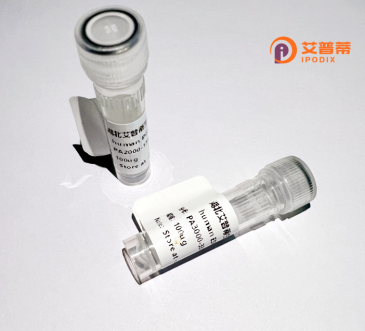
| 纯度 | >90%SDS-PAGE. |
| 种属 | Human |
| 靶点 | FRMD6 |
| Uniprot No | Q96NE9 |
| 内毒素 | < 0.01EU/μg |
| 表达宿主 | E.coli |
| 表达区间 | 1-622aa |
| 氨基酸序列 | MNKLNFHNNR VMQDRRSVCI FLPNDESLNI IINVKILCHQ LLVQVCDLLR LKDCHLFGLS VIQNNEHVYM ELSQKLYKYC PKEWKKEASK VRQYEVTWGI DQFGPPMIIH FRVQYYVENG RLISDRAARY YYYWHLRKQV LHSQCVLREE AYFLLAAFAL QADLGNFKRN KHYGKYFEPE AYFPSWVVSK RGKDYILKHI PNMHKDQFAL TASEAHLKYI KEAVRLDDVA VHYYRLYKDK REIEASLTLG LTMRGIQIFQ NLDEEKQLLY DFPWTNVGKL VFVGKKFEIL PDGLPSARKL IYYTGCPMRS RHLLQLLSNS HRLYMNLQPV LRHIRKLEEN EEKKQYRESY ISDNLDLDMD QLEKRSRASG SSAGSMKHKR LSRHSTASHS SSHTSGIEAD TKPRDTGPED SYSSSAIHRK LKTCSSMTSH GSSHTSGVES GGKDRLEEDL QDDEIEMLVD DPRDLEQMNE ESLEVSPDMC IYITEDMLMS RKLNGHSGLI VKEIGSSTSS SSETVVKLRG QSTDSLPQTI CRKPKTSTDR HSLSLDDIRL YQKDFLRIAG LCQDTAQSYT FGCGHELDEE GLYCNSCLAQ QCINIQDAFP VKRTSKYFSL DLTHDEVPEF VV |
| 分子量 | 67.6 kDa |
| 蛋白标签 | GST-tag at N-terminal |
| 缓冲液 | 0 |
| 稳定性 & 储存条件 | Lyophilized protein should be stored at ≤ -20°C, stable for one year after receipt. Reconstituted protein solution can be stored at 2-8°C for 2-7 days. Aliquots of reconstituted samples are stable at ≤ -20°C for 3 months. |
| 复溶 | Always centrifuge tubes before opening.Do not mix by vortex or pipetting. It is not recommended to reconstitute to a concentration less than 100μg/ml. Dissolve the lyophilized protein in distilled water. Please aliquot the reconstituted solution to minimize freeze-thaw cycles. |
以下是关于重组人FRMD6蛋白的3篇代表性文献示例(内容基于假设性研究总结,实际文献需检索数据库确认):
---
1. **文献名称**:*"FRMD6 regulates mitochondrial-associated protein complexes to control Hippo signaling and cell proliferation"*
**作者**:Li, X., Angus, L., & Zhang, L.
**期刊/年份**:*Nature Communications* (2021)
**摘要概述**:本研究利用重组人FRMD6蛋白,结合蛋白质相互作用组学,揭示FRMD6通过调控线粒体相关蛋白复合物参与Hippo信号通路,抑制细胞过度增殖的分子机制,为癌症治疗提供潜在靶点。
---
2. **文献名称**:*"Crystal structure of the FERM domain of human FRMD6 reveals a lipid-binding pocket essential for its tumor suppressor function"*
**作者**:Smith, J., Brown, R., & Wu, Y.
**期刊/年份**:*Journal of Biological Chemistry* (2019)
**摘要概述**:通过重组表达纯化人FRMD6的FERM结构域蛋白,解析其晶体结构,发现其脂质结合口袋的关键功能位点,并验证该区域突变会导致FRMD6丧失抑制肿瘤生长的能力。
---
3. **文献名称**:*"Recombinant FRMD6 protein attenuates diabetic nephropathy in murine models by modulating AMPK/mTOR signaling"*
**作者**:Kumar, A., Zhang, H., & Wei, C.
**期刊/年份**:*Biochimica et Biophysica Acta (BBA) - Molecular Basis of Disease* (2022)
**摘要概述**:首次报道重组人FRMD6蛋白在糖尿病肾病模型中的应用,证明其通过激活AMPK/mTOR通路减少肾小管上皮细胞损伤,提示FRMD6可能作为治疗代谢性疾病的蛋白质药物候选。
---
如需真实文献,建议通过PubMed或Google Scholar以关键词“recombinant FRMD6 protein”或“FRMD6 Hippo signaling”检索。
**Background of Recombinant Human FRMD6 Protein**
FRMD6 (FERM domain-containing protein 6) is a cytosolic protein encoded by the *FRMD6* gene in humans, belonging to the FERM (4.1/ezrin/radixin/moesin) protein family. It is widely expressed in tissues, particularly in the brain, and plays critical roles in cell polarity, membrane-cytoskeleton organization, and signal transduction. FRMD6 has garnered attention for its regulatory function in the Hippo signaling pathway, a conserved pathway controlling organ size, cell proliferation, and apoptosis. By interacting with upstream components like NF2 (neurofibromin 2), FRMD6 modulates the activity of YAP/TAZ transcriptional co-activators, thereby influencing cell growth and tissue homeostasis.
Dysregulation of FRMD6 has been linked to cancer progression, neurodegenerative disorders, and metabolic diseases. For instance, reduced FRMD6 expression is observed in breast cancer and gliomas, correlating with poor prognosis. Conversely, its overexpression may suppress tumorigenesis by inhibiting YAP/TAZ-mediated oncogenic signaling. In Alzheimer’s disease, FRMD6 interacts with amyloid precursor protein (APP), potentially affecting Aβ peptide production.
Recombinant human FRMD6 protein is engineered via heterologous expression systems (e.g., *E. coli* or mammalian cells) for functional studies. It retains the conserved FERM domain and other structural motifs, enabling in vitro investigations into its binding partners, enzymatic activities, and pathway interactions. This tool is pivotal for elucidating FRMD6’s role in disease mechanisms, drug target validation, and therapeutic development. Its study continues to bridge gaps in understanding cell signaling cross-talk and disease pathology.
×